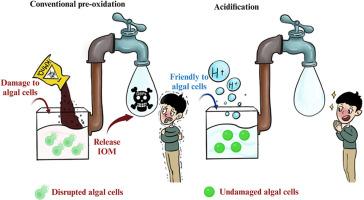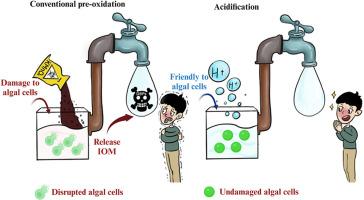机械见解酸化增强凝血:优化蓝藻去除和消毒副产物控制
IF 10
1区 环境科学与生态学
Q1 ENGINEERING, ENVIRONMENTAL
引用次数: 0
摘要
本研究开发了一种酸化强化混凝(AEC)策略,通过ph控制界面工程选择性调节藻类有机物(AOM)。FT-ICR-MS分析显示,通过温和的酸预处理(pH 5),该过程特异性靶向AOM,通过静电介导的聚集诱导低极性蛋白质和多糖减少54.1%和51.7%。由此形成的不溶性聚合物消除了混凝剂与aom的竞争性相互作用,同时保持了细胞的完整性,而传统的预氧化则会引发细胞损伤。机理研究揭示了质子化在改变AOM表面电荷分布中的关键作用,从而通过电荷中和实现有效的分离。在最佳条件下,AEC可节省60%的混凝剂,同时减少30%的消毒副产物(DBPs)形成潜力(与传统混凝相比)。选择性去除AOM和保持细胞完整性的双重机制使这种ph响应策略成为饮用水处理厂对抗蓝藻华的可持续替代方案,特别是在需要最小化化学足迹和增强过程安全性的情况下。本文章由计算机程序翻译,如有差异,请以英文原文为准。


Mechanistic insights into acidification-augmented coagulation: optimizing cyanobacterial removal and disinfection by-products control
This study develops an acidification-enhanced coagulation (AEC) strategy that selectively modulates algal organic matter (AOM) through pH-controlled interfacial engineering. By implementing mild acid pretreatment (pH 5), the process specifically targets AOM, inducing 54.1 % and 51.7 % reduction of low-polarity proteins and polysaccharides via electrostatic-mediated aggregation, revealed by FT-ICR-MS analysis. The resultant insoluble polymer formation eliminates competitive coagulant-AOM interactions while maintaining cell integrity, contrasting with conventional pre-oxidation that triggers cellular damage. Mechanistic studies reveal the critical role of protonation in modifying AOM's surface charge distribution, thereby enabling effective separation through charge neutralization. At optimal conditions, AEC achieves 60 % coagulant savings and concurrently reduces disinfection by-products (DBPs) formation potential by 30 % (compared with traditional coagulation). The dual mechanism of selective AOM removal and cell integrity maintaining positions this pH-responsive strategy as a sustainable alternative for drinking water treatment plants combating cyanobacterial blooms, particularly in scenarios requiring minimized chemical footprint and enhanced process safety.
求助全文
通过发布文献求助,成功后即可免费获取论文全文。
去求助
来源期刊

Journal of Cleaner Production
环境科学-工程:环境
CiteScore
20.40
自引率
9.00%
发文量
4720
审稿时长
111 days
期刊介绍:
The Journal of Cleaner Production is an international, transdisciplinary journal that addresses and discusses theoretical and practical Cleaner Production, Environmental, and Sustainability issues. It aims to help societies become more sustainable by focusing on the concept of 'Cleaner Production', which aims at preventing waste production and increasing efficiencies in energy, water, resources, and human capital use. The journal serves as a platform for corporations, governments, education institutions, regions, and societies to engage in discussions and research related to Cleaner Production, environmental, and sustainability practices.
 求助内容:
求助内容: 应助结果提醒方式:
应助结果提醒方式:


